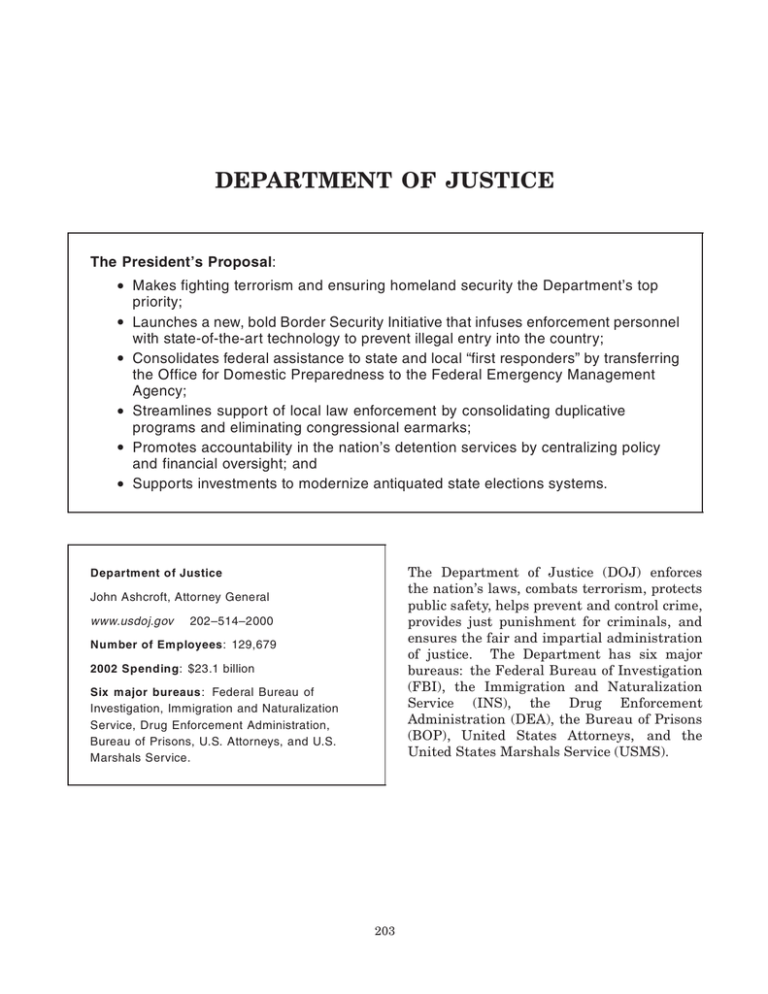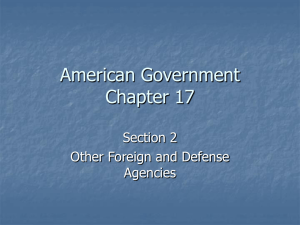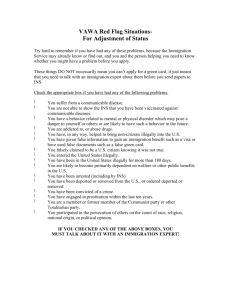DEPARTMENT OF JUSTICE •
advertisement

DEPARTMENT OF JUSTICE The President’s Proposal: • Makes fighting terrorism and ensuring homeland security the Department’s top • • • • • priority; Launches a new, bold Border Security Initiative that infuses enforcement personnel with state-of-the-art technology to prevent illegal entry into the country; Consolidates federal assistance to state and local “first responders” by transferring the Office for Domestic Preparedness to the Federal Emergency Management Agency; Streamlines support of local law enforcement by consolidating duplicative programs and eliminating congressional earmarks; Promotes accountability in the nation’s detention services by centralizing policy and financial oversight; and Supports investments to modernize antiquated state elections systems. The Department of Justice (DOJ) enforces the nation’s laws, combats terrorism, protects public safety, helps prevent and control crime, provides just punishment for criminals, and ensures the fair and impartial administration of justice. The Department has six major bureaus: the Federal Bureau of Investigation (FBI), the Immigration and Naturalization Service (INS), the Drug Enforcement Administration (DEA), the Bureau of Prisons (BOP), United States Attorneys, and the United States Marshals Service (USMS). Department of Justice John Ashcroft, Attorney General www.usdoj.gov 202–514–2000 Number of Employees : 129,679 2002 Spending : $23.1 billion Six major bureaus : Federal Bureau of Investigation, Immigration and Naturalization Service, Drug Enforcement Administration, Bureau of Prisons, U.S. Attorneys, and U.S. Marshals Service. 203 204 DEPARTMENT OF JUSTICE Defending the Nation Against Public Enemy Number One Defending the nation and its citizens against terrorist attacks and ensuring the protection and security of our homeland under the law is now the Department of Justice’s first priority. The Department has promised the American people that it will: • disrupt and dismantle terrorist activity • • Terrorists strike on American soil. The September 11th attacks on the World Trade Center, the Pentagon, and in the air over Pennsylvania brought home the heightened threats to the nation and illustrated tragically the gaps in our counterterrorism efforts. While many corrective actions have been taken, such as the shutting down of financial networks exploited by many terrorists, much remains to be done. The President’s Budget proposes a number of initiatives to address these challenges and increases funding by $2.0 billion to support these efforts. As shown in the accompanying table, most of this funding goes to the FBI and INS. and terrorist networks; bolster homeland security by preventing terrorist attacks before they occur; and help bring to justice those who would perpetrate terrorist acts against Americans. 2003 Counterterrorism Enhancements (Budget authority in millions of dollars) Immigration and Naturalization Service .............. 994 Federal Bureau of Investigation ............................ 646 United States Attorneys ......................................... 99 General Legal Activities ......................................... 35 Counterterrorism Fund .......................................... 35 United States Marshals Service ........................... 47 All other .................................................................... 118 Total .......................................................................... 1,974 The Mission: Seek, Find, Destroy Some of the major areas proposed for improvement are highlighted below. • Timely and useful intelligence is a key to preventing terrorist attacks. • The budget provides $155 million for the FBI and INS to improve their intelligence gathering and dissemination capabilities. This funding would support additional intelligence analysts, surveillance staff, and electronic surveillance equipment. It would also expand the use of Joint Terrorism Task Forces, which combine the resources and talents of federal, state, and local law enforcement agencies at locations throughout the country. This funding also includes $35 million for the Attorney General to enhance other intelligence gathering capabilities, including those of the Drug Enforcement Administration. Cybercrime attacks against our critical infrastructure could result in major disruptions and economic loss. The budget strengthens the FBI’s efforts to detect and prevent such attacks. THE BUDGET FOR FISCAL YEAR 2003 205 • The northern border has become an attractive gateway for potential terrorists. The budget builds on 2002 initiatives for the northern border by adding enough resources to more than double the number of Border Patrol agents and inspectors and design and construct new Border Patrol and inspection facilities. Putting Technology on the Beat The 2003 Budget also expands ongoing efforts to correct the FBI’s seriously deficient information technology infrastructure by providing $186 million for additional upgrades. While the FBI will continue to face information technology challenges beyond 2003, the funding that has been provided in 2002 and requested for 2003 will enable the FBI to enhance internal communications, upgrade personal computers, and institute new security measures. Out with the Old... In with the New The FBI’s basic information technology capabilities have fallen behind other government agencies and the private sector. Speedy personal computers are not available to many FBI employees. Inefficient sharing and searching of information contained in the FBI’s many databases hinder investigations. Databases housing sensitive information need to be better protected from external attacks and internal misuse, as evidenced by the loss of classified information to convicted spy Robert Hanssen. The FBI is aggressively correcting this situation, using a large infusion of funds provided in 2002. To be effective, law enforcement programs must be supported by a wide array of physical and technical capabilities and infrastructure. The budget includes a number of initiatives to improve current capabilities. For example, the INS will modernize and expand its systems to control aliens entering and exiting the United States through visitors’, temporary workers’, and other visas. Also, FBI and DEA will improve safeguards that protect critical information systems from unauthorized access or misuse. Also, the FBI will replace older fleet aircraft with newer, more sophisticated aircraft with advanced surveillance and investigative capability. The INS will increase its air surveillance fleet to enable more thorough coverage of border areas. The FBI and DEA will also improve protection for their personnel, facilities, and information from attack and the U. S. Marshals Service will upgrade security at federal courthouses nationwide. 206 DEPARTMENT OF JUSTICE Border Security To address the gap in securing the nation’s borders, the budget proposes a bold, new initiative. The Border Security Initiative brings additional law enforcement personnel together with advanced, state-of-the art technology and systems to better prevent illegal entry into the country, target persons who are a threat to homeland security, and assist with non-U.S. citizens entering and exiting the country. Components of this initiative include: • Implementing • a comprehensive entry/exit system to track the arrival and departure of non-U.S. citizens while speeding entry of routine, legitimate traffic and dramatically improving our ability to deny access to those that should not enter. The new system will leverage advanced technology and construction investments to ensure a timely and secure flow of traffic; Deploying force-multiplying equipment, including remote operated infrared cameras, to monitor isolated areas where illegal entry may have once occurred; and • Integrating now-separate information systems to ensure timely, accurate, and complete enforcement data is available to the field. The Honor System Gone Haywire When Immigration inspectors close up shop, those who wish to cross the border are on their honor to either report to the unmanned video camera or wait until morning. Prior to the September 11 th attacks, many northern border crossings were left unmanned overnight. So persons wishing to enter the U.S. legally were required to turn back and wait until the next morning or proceed, often many miles, to the nearest open port-of-entry. No effective border enforcement was in place at these locations. Today, as a result of emergency funding to cover overtime pay, all official border crossings are manned 24 hours a day, seven days a week. Status Report on Select Programs The Administration is reviewing programs throughout the federal government to identify strong and weak performers. The budget seeks to redirect funds from lesser performing grant programs or those that have outlived their usefulness, to those programs that support the fight against terrorism and ensure that our homeland is secure. THE BUDGET FOR FISCAL YEAR 2003 Program Assessment 207 Explanation Immigration enforcement Moderately Effective Immigration enforcement activities have made progress in gaining control along specific sections of the Southwest border, resulting in a decrease in apprehensions. Yet, total illegal immigration, including people overstaying their visas, remains high. Immigration services Ineffective Unacceptably large application backlogs and lengthy processing times frustrate those who wish to legally enter the United States, unfairly disadvantaging them relative to undocumented immigrants. The Department is, however, making progress toward eliminating the backlog by the end of 2003, but needs to ensure a thorough screening of all applicants for deficiencies. Community Oriented Policing Services (COPS) Unknown COPS grants have contributed to the spread of innovative police practices. However, the net effect on police hiring and national and local crime rates is uncertain. Other State and Local Grant Programs Unknown The overall effect on crime is unknown because of widely varying program objectives, the lack of performance measures, and the relatively small share of local criminal justice spending. Congressional earmarks also limit the Department’s ability to target funding where it is needed most. Incarceration Effective Although the current supply of prison bed space is inadequate, alternative solutions are being utilized to address the problem. Additional prison capacity, either from new prison construction or the purchase of private or other prison facilities, will reduce crowding levels and continue to provide secure and humane confinement for inmates. 208 DEPARTMENT OF JUSTICE Redirecting Funds from Outmoded, Underperforming Programs to New Initiatives To help offset the cost of increased funding for homeland security and counterterrorism in DOJ, the budget proposes reductions in grant and other departmental programs that have accomplished their mission, failed to demonstrate a clear impact on crime, or have been extensively earmarked by the Congress. State and Local Assistance Programs As discussed in the Federal Emergency Management Agency (FEMA) chapter, the budget requests $3.5 billion for FEMA to improve the terrorism preparedness of state and local first responders, including police, fire and emergency personnel. This represents a shift in priorities and funding from Department of Justice grants, which are reduced by $1.2 billion. However, total federal aid to state and local law enforcement will increase. In recent years, departmental state and Sources of State and Local Law local assistance programs have included the Enforcement Funding In billions of dollars State Criminal Alien Assistance Program Federal First (SCAAP), Byrne formula grants, Local 160 Responder Law Enforcement Block Grants, Juvenile Federal Law Grants Enforcement Accountability Block Grants, and COPS hiring 120 Grants grants. Despite spending billions of dollars since 1994, virtually no evidence exists proving State 80 that these programs have had an impact on the nation’s falling crime rate, and all lack 40 verifiable measures of performance. SCAAP is Local not even intended to reduce crime, but merely to reimburse state and local government 0 1994 1995 1996 1997 1998 1999 2000 2001 2002 2003 expenditures. Nevertheless, the President’s Source: State and local data from Bureau of Justice Statistics. Budget continues to support flexible grant funding for state and local law enforcement by merging several of these block grants into a new Justice Assistance Grant Program with stronger emphasis on performance accountability. This program will be funded at $800 million. Alternatives to Prison Construction Between 1993 and 2001, the federal government has spent over $4 billion constructing new prisons. During that time, the federal prison population has grown by over 76 percent, from 88,565 in 1993 to 156,572 in 2001. In response to rapid inmate growth, federal prison facilities grew from 72 in 1993 to 100 in 2001, with 18 additional institutions now underway. Purchase of excess private sector and other correctional facilities may offer an affordable alternative to federal construction of additional prison space. The Department will evaluate the feasibility of purchasing private facilities for use by BOP. THE BUDGET FOR FISCAL YEAR 2003 209 Other Changes to Improve Program Performance Congressional Earmarks Crime rates remain at their lowest level in over 25 years, and the Department continues to spend over $4 billion a year to help state and local governments prevent, investigate, prosecute, and punish criminal behavior. While some programs that focus resources on high-crime areas have been effective, most of the several dozen Justice grant programs has not demonstrated a clear impact on crime. Their effectiveness and accountability have been further compromised by the congressional practice of earmarking funds for unrequested, non-competitive projects. In 2002, earmarked projects made up 15 percent of total grant funding and 32 percent of non-formula funding. Some programs were hit especially hard: 100 percent of the COPS Law Enforcement Technology Program; 42 percent of the Methamphetamine Enforcement and Clean-Up Initiative; 75 percent of Crime Identification Technology Act Grants; and 99 percent of the Safe Schools Initiative. The Edward Byrne discretionary grant program had 98 percent of its appropriation earmarked, including $2 million for a Rural Agricultural Crime Program in California; $1 million for a distance degree program at Excelsior College, N.Y.; and $3 million for the Lewis and Clark Bicentennial Bi-State Public Safety Project in Idaho. The budget consolidates these programs, eliminates earmarks, and, as part of the President’s Homeland Security initiative, funds efforts where all levels of law enforcement entities can combat the threat of terrorism. Office of the Federal Detention Trustee The need for federal detention bed space has more than doubled in the last five years, from 32,000 detainees in 1996 to 67,000 detainees in 2001. This dramatic rise has resulted in an increased reliance on state and local governments and private contractors to provide bed space for federal detainees. This year alone, the Department will spend $1.8 billion on federal detainees. Currently, the INS, USMS, and BOP detain prisoners, with little department-wide coordination. Previously, the Office of the Federal Detention Trustee was established to manage the rising detainee population and exercise financial control and efficiency in federal detention operations. For 2003, the Administration proposes consolidating detention funding from INS and the Federal Prisoner Detention program under the Detention Trustee to improve financial accountability and ensure coordination throughout the department. This is the first crucial step toward achieving the Administration’s goal of centralizing federal detention policy-making and funding and redresses the disconnect between the Department’s bureaus. Office of Domestic Preparedness The budget transfers the functions of the Office for Domestic Preparedness (ODP) to FEMA, together with $235 million in funding. ODP has provided anti-terrorism equipment grants and training for state and local first responders. 210 DEPARTMENT OF JUSTICE Timely Citizenship Bring Us Your Tired, Your Poor, Your Hungry … A Promise of Better Service Thousands of people endure long waits at INS offices or at home for action on their immigration application. Those waiting in line hope that today they can talk with an INS official and file an immigration application. Others wait at home for months and even years to hear from the INS. This is an unacceptable situation − the immigrants to our country deserve better. By the end of 2003, the INS expects to achieve a six-month average processing goal for all applications. In addition to securing the border, the INS is also responsible for processing immigration applications and petitions, such as “green card” or citizenship applications. Currently it takes on average 13 months for the INS to decide on an application for a green card. For someone to sponsor their relative to immigrate to the United States, it can take the INS anywhere from 19 to 43 months to process the request. Persons seeking citizenship wait 10 months on average. The Administration is committed to building and maintaining an immigration service system that ensures integrity, provides timely and accurate services, and emphasizes a culture of respect. Last year, the Administration launched a five-year initiative to provide quality service to all legal immigrants, citizens, businesses and other INS customers. To support this commitment, the INS has developed a five-year plan to eliminate the immigration benefit backlog, a component of which is to ensure the thorough screening of all immigration applicants for deficiencies prior to their being admitted into the United States. The plan also provides for a six-month processing standard for all applications. In 2002, INS will implement several information technology initiatives to improve customer service, including providing on-line filing of multiple immigration applications. In addition, to improve the efficiency and effectiveness of the INS in achieving its mission, in November 2001 the Attorney General unveiled a restructuring plan for INS that will reform the agency’s structure by separating its service and enforcement functions. The restructuring of INS fulfills U.S. citizenship ceremony. President Bush’s pledge to reform the agency by creating a clear division between INS’ two vital missions—service and enforcement. THE BUDGET FOR FISCAL YEAR 2003 211 Election Reform Grants The budget includes $400 million in 2003 for a new DOJ matching grant program to enable state and local jurisdictions to take advantage of improved voting technologies and administration, including voting machines, registration systems, voter education, and poll worker training. This new program is consistent with the recommendations of a report on election reform issued by a national commission headed by former Presidents Ford and Carter. Strengthening Management In 2001, the Attorney General established the Strategic Management Council (SMC) to provide direction and leadership on strategic planning, resource management, and performance accountability. This “corporate board” now oversees the Department’s resources and provides direction and leadership for long-range planning. The SMC evaluates and prioritizes funding requests submitted by departmental bureaus and was instrumental in aligning the budget request with the Department’s strategic goals and objectives. The Department is making progress in addressing various President’s Management Agenda initiatives. Initiative 2001 Status Human Capital —The Department submitted a workforce-restructuring plan that was developed prior to the attacks of September 11th . The plan did not address the following core criteria: human capital planning; standards for internal accountability systems; or a comprehensive citizen-centered, de-layered organizational structure. On November 8, 2001, the Attorney General announced a comprehensive reorganization to meet the counterterrorism mission. The Department’s human capital strategy will be revised to address this new restructuring. The revised plan will ensure that the Department sustains a high-performing workforce that is continually improving in productivity and strategically uses existing personnel, tools, and technology. Specifically, the revised plan will: 1) identify skill gaps and deficiencies; 2) describe strategies to reward high performers and address low performance; and 3) develop an outsourcing strategy to accommodate the needs of displaced employees. • Competitive Sourcing —The Department has not completed public-private or direct conversion competition for 15 percent of the government positions performing commercial functions. The Department has a competitive sourcing plan for achieving the five percent goal in 2002 and 15 percent by 2003, equating to 190 positions, based upon a 2000 commercial activities inventory of 1,264. Justice has increased the size of its commercial activities inventory from one percent in 2000, to over nine percent of its total workforce. The Department needs to continue to identify additional positions that could be added to its commercial activities inventory. • 212 DEPARTMENT OF JUSTICE Initiative Financial Management—The Department is not in compliance with the requirements of the Federal Financial Management Improvement Act. The Department also does not meet federal accounting standards related to property accounting. Since the Department has material system non-conformances, it cannot provide a clean assurance statement about its controls. Justice received a clean opinion on two of its financial statements (i.e., the balance sheet and statement of custodial activity) and a qualified opinion on the remaining statements for 2000, due to lingering accounting problems at the INS. 2001 Status • The Department has made progress in addressing issues identified by its auditor during the course of its annual financial audit. Justice expects to receive an unqualified opinion for 2001. In addition, DOJ will move forward to migrate its components from old financial systems to new systems that meet applicable standards. E-Government —The Department has a number of significant and pervasive information technology security weaknesses. In spite of recent progress, significant work remains to carry out a capital planning process fully. Justice’s timetable calls for all bureaus to have completed plans by the end of 2002. To ensure system compatibility and improve information sharing and security, Justice’s enterprise architecture efforts must be a high priority throughout the Department. • Budget/Performance Integration —The Department does not have a performance plan that is tied to specific outputs, outcomes, or activities. There is no clear linkage between resource levels and outcomes. On November 8, 2001, the Attorney General announced a series of goals and management initiatives that reflect the changed priorities of the Department. These goals include revising the Department of Justice Performance plan to include clear, consistent performance measures that support the Department’s Strategic Plan. The Department will focus on revising its plan and on improving the linkages between resources and outputs/outcomes in budget formulation and execution. In addition, the Department will demonstrate how performance influences budget decisions. • THE BUDGET FOR FISCAL YEAR 2003 213 Department of Justice (In millions of dollars) 2001 Actual Estimate 2002 2003 Spending: Discretionary Budget Authority: Federal Bureau of Investigation ............................................. Drug Enforcement Administration .......................................... Immigration and Naturalization Service 1 ............................ Federal Prison System ............................................................ U.S. Marshals Service ............................................................. U.S. Attorneys ........................................................................... State and Local Assistance .................................................... All other programs .................................................................... Subtotal, gross discretionary budget authority adjusted 2 ...... Less Crime Victims Fund delay 3 .......................................... Remove contingent adjustments .......................................... Total, Discretionary budget authority ......................................... 3,363 1,417 3,350 4,415 626 1,303 4,640 2,518 21,632 — −440 21,192 3,641 1,517 3,596 4,744 670 1,397 4,263 2,098 21,926 — −465 21,461 4,324 1,582 4,132 4,605 737 1,551 3,071 3,069 23,071 −1,261 −492 21,318 Emergency Response Fund, Budgetary Resources: Federal Bureau of Investigation ............................................. Immigration and Naturalization Service ................................ Office of Justice Programs ...................................................... All other programs .................................................................... Total, Emergency Response Fund, Budgetary resources ...... 37 — — 4 41 785 584 19 103 2,191 — — — — — Mandatory Outlays: Immigration and Naturalization Service ................................ September 11 th Victims Compensation ................................ All other programs .................................................................... Subtotal, Mandatory outlays adjusted 2 .................................... Less mandatory receipts ......................................................... Remove contingent adjustments ............................................ Total, Mandatory outlays .............................................................. 1,497 — 1,117 2,614 −1,998 −45 571 1,687 1,080 1,667 4,434 −2,576 −51 1,807 2,091 2,700 2,536 7,327 −2,605 −54 4,668 1 In 2003, $615 million is transferred from INS to the Detention Trustee, and is included in the "All Other Programs" total. 2 Adjusted to include the full share of accruing employee pensions and annuitants health benefits. For more information, see Chapter 14, "Preview Report," in Analytical Perspectives. 3 Savings from the Crime Victims Fund were $525 million in 2001 and $1,033 million in 2002.




